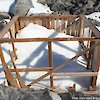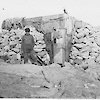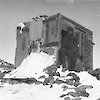Temples to science
As soon as outer cladding of the two main huts was completed, Cecil Madigan and Eric Webb got to work on edifices of a different kind.
Madigan had responsibility for observing and recording the weather of Cape Denison. To do so, he needed to erect two ‘Stevenson’ screens — named after their 19th century inventor — to protect his instruments from the elements while allowing free air circulation around them. Wire with a one-tonne breaking strength was used for stays to keep the screens upright in heavy winds, but even these were broken on occasions during the year by the force of the katabatics.
Webb was in charge of magnetic observations, which had a prominent place in the Cape Denison scientific program. For this he needed two buildings — one to house the magnetographs that recorded variations in Earth’s magnetic field, and the other to allow ‘absolute’ measurements which would serve as a reference point for the magnetograph observations.
Both buildings needed to be separate from each other and a good distance from the ferrous materials in and around the Main Huts. They also needed to be free of ferrous materials themselves — hence copper nails and fittings taken from the Clyde shipwreck on Macquarie Island were used in their construction – and to be insulated against temperature fluctuations.
First came the ‘Absolute Hut’, built using remnant timbers left over from the main building works. About 1.8 by 1.8 metres, it was sited on a raised rock shelf on the eastern arm of Boat Harbour, about 350 metres northeast of the Main Hut. Its instruments were set into rock to ensure stability, and the measurements were taken through small sliding doors (without entering the single room).
After its completion in February, Webb and Frank Stillwell, along with Edward Bage and various others, erected the ‘Magnetograph Hut’, about 50 metres north of the Absolute Hut. They needed two attempts; wall frames were flattened by a heavy gale late in February. As with the Absolute Hut, instruments were set into rock, and insulation was provided by surrounding rocks and by sheepskin and hessian outer roof cladding.
Another building was added over a year later. The ‘Transit Hut’ (or ‘Astronomical Observatory’) was erected in May 1913 on a metre-high rock ledge about 30 metres northeast of the Main Hut. It was built from scrap timber and covered in canvas to try to proof it against intrusive snow-drift. A ‘10-inch transit instrument’ fixed in a wooden frame set into rock would provide the astronomical information necessary to fix the exact longitude of Cape Denison.
First blizzard at the Hut
Excerpt from Antarctica Pioneers (1962). Cinematography by Frank Hurley. © Australian Antarctic Division
First blizzard at the Hut
Video transcript
Frank Hurley: We had scarcely got our hut up at the winter quarters, Cape Denison, when we had our first bad blizzard. Little did we imagine, when we landed in calm sunshine, that we had established ourselves in the most tempest-ridden spot on the face of the globe. We developed a technique of walking about, but any routine work beyond shelter became a struggle against tempest and frostbite. For the whole year the average wind velocity was 48.5 miles an hour. The worst day was in May, when the wind reached 90.1 miles continuously for an hour.
[end transcript]




